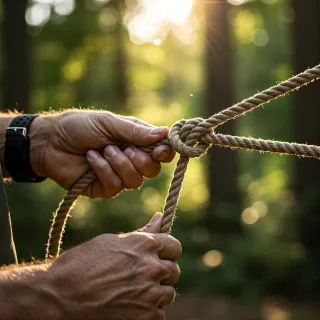Bowline Knot
Loop knot that's easy to tie - and easy to untie
The Bowline is often described as a very ancient knot and without question, it is usually one of the first loop knots taught in any outdoor program.
Uses: The Bowline is a type of knot known as a Loop Knot. Loop knots are used to create a fixed, non-adjustable loop or multiple loops in a rope. Loop knots don’t change shape when pulled or removed from an object. There are two types of loop knots: those that are tied at the end of a rope and mid-line loops. The Bowline is an example of an end-of-line loop knot, however, there are different variations of the bowline, including the bowline on a bight, which is tied mid-line.
Alternate Names: The Bowline doesn’t have any other names however, as mentioned, there are several different variations of the bowline, each with its own name to identify it.
Knot Structure: The Bowline has a similar structure to the Sheet Bend, and we could consider the Sheet Bend to be the foundation of this knot. However, the Bowline is also a foundation knot and you can find it’s structure within many different knots, such as the Cowboy Bowline, Bowline on a Bight and Eskimo Bowline.
How to Tie: There are a few different methods to tie the Bowline. The most common method when first introducing the knot is often described with the moniker of a rabbit jumping up out of its hole, running around a tree and then back down it’s hole.
To tie the Bowline, begin by a loop in your working line. From there pass the working end up through the loop and around the back of the standing part. From there, pass the working end back down through the loop. And then cinch up the knot.
Uses: You can find the Bowline in use in a lot of applications, including by arborists, in boating or sailing, camping, climbing and home and garden. Practically anywhere when you need a simple loop knot.
Dangers: Despite the Bowline having an excellent reputation, the danger of the Bowline is that it can slip when tied in some modern synthetic ropes and also if the line doesn’t maintain tension. However, in many conditions, the Bowline is well suited, because it can be easily tied and easily untied even after being heavily loaded.
One of the easiest ways to make the Bowline more secure is to add a half hitch with the tail end and tie a Half-Hitched Bowline. Backing up the Bowline will reduce the risk of the knot slipping when tension is lost.
Ashley Book of Knots Reference: You can find the Bowline as knot number 287 on page 49, 1010 on page #186, and 1716 on page 295 of the Ashley Book of Knots.
For people serious about learning knots.
The KnotSkool is a private membership community and learning platform where like-minded people come together in pursuit of common goals for learning and sharing knowledge about knots.
When you become a member, you gain access to the most comprehensive and high-quality course material available. Access to an incredible network of mentors and learners, and other membership perks.
The KnotSkool makes learning knots easy.
I Consent to Receive Email Notifications, including Account Login Information, Alerts, & Newsletters from KnotSkool. You can unsubscribe at any time. As a member I also agree to the terms of service and privacy policy of KnotSkool.
Your first 14 Days are Free!
Most People Fumble with Knots: Mastering These Five Knots Will Transform Your Wilderness Skills
A well-tied knot is more than just a fastening; it's a statement of skill and preparedness. This article will provide practical knowledge in knot-tying, you'll learn five essential knots and understan... ...more
Knots
February 05, 2025•6 min read

Quick Links
Home
Members
All Rights Reserved
